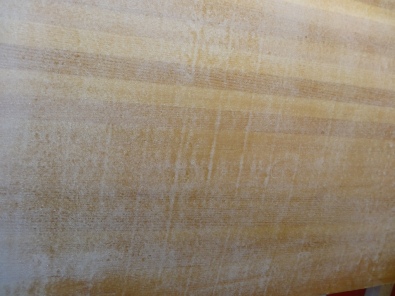





When the epoxy had hardened the next day, with some trepidation I pulled off the peel-
My other mistake was to not take enough care when aligning the tapers on the edges of the glass cloth. This needs to be done with great precision, because if, as happened with me, there is not quite enough overlap then when cured there is a small indentation along either side of the joint.
Because sanding through the fibres of the glass weakens the coating, after I had removed the peel ply, I brushed on a further coat of epoxy to allow me to sand the hull, and thus remove some of the more obvious lumps and dips. During this sanding process, I noticed a series of small, parallel ridges in the surface, and at first I was confused as to their origin. For those of you who are not familiar with peel-
(Note to the uninitiated: amine blush is a white waxy substance that forms on the surface of epoxy as it cures, especially if there is a high humidity. It can be easily washed off with detergent and water, otherwise subsequent coatings will not bond properly.)

Peel-
| Centreboard case assembly |
| Bevel_Jig_Photos |
| Bow clamp |
| Progress! |
| Strip clamp (Mark 2 B) |
| Bow clamps again |
| Strip joint! |
| The hull at 6th June 2017 |
| Sanding the hull |
| Applying the fibreglass |
| Peel-ply and amine blush |
| Suppliers_2 |